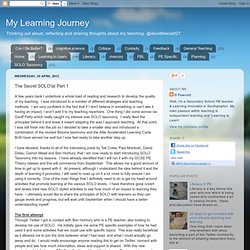

SOLO Taxonomy. Solo Geography 21 Category links. Introducing SOLO Taxonomy. Shp-solo-final-2013. Purple Elf's Learning Adventures. Session 99 – How can we spread the benefits of a new taxonomy with SOLO? The #ukedchat of Thursday 24 May 2012 – there was a tie in the poll between SOLO taxonomy and how it could be embraced and developed as a new taxonomy in schools and the discussion about how secret learning spaces can be used to schools to promote learning in spaces other than classrooms. With it being a tie, host Mark Anderson was given the choice of topics.
He chose SOLO. With that, certain questions needed to be addressed: • What is SOLO? • What are the benefits of SOLO? • How can it be implemented at Primary? It was argued by some that they didn’t know what it was and so the questions above were answered. It was found that SOLO is a really good way to ensure that students understand how their learning relates to the subject content in their lessons.
@Blenkaz commented “Do-able in primary and my y3 class managed well considering it was first attempt! Tweet of the week: Solo lessons allow teacher to hand learning over rather than chalk and talk technique. Archive Session. SOLO Taxonomy Resources. Helping students to progress using the SOLO Taxonomy. . Our Solo Taxonomy. Using SOLO Taxonomy to Develop Student Thinking & Learning. The 15 minute forum was led by Simona Trignano (newly appointed Deputy Leader in Science, KS3 – @simonatrignano).

During the session Simona went through the work that she has been doing this year as a part of her ‘Learning Innovator’ project – on SOLO taxonomy. What is SOLO Taxonomy? SOLO (Structure of Observed Learning Outcomes) provides a structured framework for students to use to progress their thinking and learning. It encourages students to think about where they are currently with there learning, and what they need to do in order to progress. There are five main stages: This is the first stage – where students don’t really have any knowledge or understanding of the topic being studied. Moving on from pre-structural, students who are unistructural have a limited knowledge of the topic – they may just know one isolated fact about the topic. ‘I have some understanding of this topic’ So a typical student ‘relational response might be: An example…. Prestructural – “Err…..What?” SOLO Resources. Access your bookmarks anywhere.
Redesigning Classrooms: Spreading and Embedding the SOLO Taxonomy. In this set of posts about redesigning classrooms I want to look at some of the changes that teachers can incrementally make to their classrooms that may over time transform their practice.

The first post about the SOLO Taxonomy can be found here: Redesigning Classrooms: Using SOLO to Increase Challenge SOLO first appeared as part of our CPD programme a number of years ago and all staff are familiar with it, however, a number of staff have started taking the use of the SOLO Taxonomy to new levels, spreading and embedding its use as they go.
One of the interesting dimensions of the work is how staff are using the SOLO Taxonomy with students and explicitly developing their understanding of it and how to use it to increase the depth of the work they are doing. This post is a series of short inputs from staff at St. Art, Design & Technology Department – Student Friendly Success Criteria (Anna Johnson – HoD) Example of success criteria for students in Food Technology. Constructive alignment tool – SOLO Taxonomy. PRIMER-on-Learning-Outcomes. Introducing SOLO in English. SOLO Taxonomy Click here to find out what it is before reading how you might use it in English SOLO makes self and peer assessment in English much more accessible to pupils.

It provides them with a clear path to higher order thinking about their topics. Once they have been taught the features of each level and how each level leads to the next, they are quickly able to use it to move themselves forward. To get pupils using SOLO effectively, it needs to be properly introduced. Introducing SOLO is likely to take at least one full lesson but trust me this is learning time well spent.
The Shakespeare Introduction I began by posing a question “Did Shakespeare write every story ever written?” SOLO taxonomy. I am pleased to say that John Biggs himself has endorsed this representation of his ideas; "I've just found your website on SOLO et al. via google.

I'm delighted! Your diagrams of prestructural-extended abstract are very elegant... " (Unsolicited email, 29 May 2005) Half The Teaching = Double The Learning. The Secret SOLO'ist Part 1. A few years back I undertook a whole load of reading and research to develop the quality of my teaching.

I was introduced to a number of different strategies and teaching methods. I am very confident in the fact that if I don't believe in something or can't see it having an impact, I won't add it to my teaching repertoire. One thing I did come across via Geoff Petty which really caught my interest was SOLO taxonomy. I really liked the principles behind it and knew it meant adapting the way I approach teaching. At that point, I was still fresh into the job so I decided to take a smaller step and introduced a combination of the revised Blooms taxonomy and the Alite Accelerated Learning Cycle. I have decided, thanks to all of the interesting posts by Tait Coles, Paul Mcintosh, David Didau, Darren Mead and Ben Horbury, that I am now ready to start introducing SOLO Taxonomy into my lessons. The session was loosely based around SOLO and used some slides that Ben Horbury had shared with my.
The Secret SOLO'ist Part 1. Introduction to SOLO taxonomy.